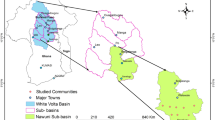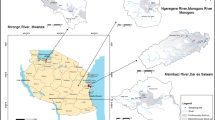Abstract
At present, water pollution is still a serious problem in some parts of China. Clean water corridor technology (which provides water quality assurance and pollution load reduction from the Major Science and Technology Program for Water Pollution Control and Treatment) is a river pollution control and treatment measure. However, due to the differences of specific river conditions, it is not initially clear which technology can be used to obtain the best effect. Numerical simulation can address this issue. The results can be used as the basis for selecting clean water corridor technology. Combined with remote sensing (RS) and geographic information system (GIS) technology, the relationship between land use and non-point source pollution load was analyzed by using the HSPF (Hydrological Simulation Program-Fortran) model. According to the distribution of pollution load, the effect of the clear water corridor technology and its combination scenario on the reduction of non-point source pollution in the basin was simulated, and the best clear water corridor technology scheme for the control of non-point source pollution was identified. Research results show that from 2015 to 2018, the non-point source pollution load of total nitrogen in the Paihe River basin showed an overall increasing trend, while the total phosphorus showed a slightly increasing trend. Agricultural land and construction land accounted for 70% and 20%, respectively, of the non-point source pollution load, and the change in land use played an important role in the load of non-point source pollution. In terms of spatial distribution, the non-point source pollution of total nitrogen and total phosphorus was mainly concentrated in the downstream region and the central region. The non-point source pollution load reduction rates of total nitrogen and total phosphorus by the three types of clean water corridor technologies of vegetation buffer zones, permeable sidewalks and constructed wetlands, and their combinations were 15.29% and 15.03%, 11.93% and 11.48%, 8.96% and 8.67%, and 24.12% and 23.20%, respectively. It is necessary to comprehensively adopt clean water corridor technology for an optimal allocation and reasonable layout and to increase the pollution load reduction rate to further achieve ecological environment restoration goals.
Graphical abstract










Similar content being viewed by others
Data availability
All data generated or analyzed during this study are included in this published article and its supplementary information files.
References
Arnold JG, Srinivasan R, Muttiah RS, Williams JR (1998) Large area hydrologic modeling and assessment Part I: model development. J Am Water Resour Assoc 34(1):73–89
Baker TJ, Miller SN (2013) Using the soil and water assessment tool (SWAT) to assess land use impact on water resources in an east african watershed. J Hydrol 486:100–111
Beasley DB, Huggins LF, Monke EJ (1980) ANSWERS: A Model for Watershed Planning. Trans ASAE 23(4):938–944
Cao FF, Li X, Wang D et al (2013) Effects of land use structure on water quality in Xin'anjiang River. Environ Sci 34(7):2582–2587
Chen J, Liu YH, Yu ZR (2011) Non-pollution of the Hangbu-Fengle River basin in Chaohu under different land use scenarios. J Shaanxi Normal Univ 39(4):86–90
Chung ES, Lee KS (2009) Prioritization of water management for sustainability using hydrologic simulation model and multicriteria decision making techniques[J]. J Environ Manag 90(3):1502–1511
Corwin DL, Loague K, Ellsworth TR (1998) GIS-based modeling of non-point source pollutants in the Vadose Zone. J Soil Water Conserv 53(1):34
Doherty J, Skahill BE (2006) An advanced regularization methodology for use in watershed model calibration. J Hydrol 327(3):564–577
Dong, Y.J., Li, J., Zheng, J.L., et al., 2009.Basin hydrological water quality simulation software (HSPF) application guide. Yellow River Water Conserv Press, 2009.
Dong YJ, Chen WL, Yang F, et al., 2014. Principle and simulation application of HSPF watershed model. The Yellow River Water Conservancy Press, 2014.
Duda PB, Kittle JL, Gray MH, Hummel PR, Kinerson RS, Cocca P (2003) BASINS 4.0-flexible integration of components and data for watershed assessment and TMDL Development. Proc Water Environ Fed 2003(4):53–68
Hao FH, Cheng HG, Yang ST, 2006.Non-point source pollution model—theoretical methods and applications. China Environ Sci Press, 2006.
Hong HS, Huang JL, Zhang LP et al (2005) Modelling pollutant loads and management alternatives in Jiulong River watershed with AnnAGNPS. Environ Sci 26(4):63–69
Im SJ, Brannan KM, Mostaghimi S et al (2007) Comparison of HSPF and SWAT models performance for runoff and sediment yield prediction. J Environ Sci Health Part A 42(11):1561–1570
Laroche AM, Gallichaud J, Robert L, Alain P (1996) Simulating atrazine transport with HSPF in an agricultural watershed. J Environ Eng 122(7):622–630
Li HE, Shen J, 2015. NSP Mathematical Model. Northwestern Polytechnical University Press, 1996.
Lihong Z. (2016) Study on runoff parameter optimization and uncertainty of HSPF model [D]. Zhejiang University. (in Chinese)
Mandeville AN, O'Connell PE, Sutcliffe JV, Nash JE (1970) River flow forecasting through conceptual models part III - The Ray catchment at Grendon Underwood[J]. J Hydrol 11(2):109–128
Mishra A, Kar S, Raghuwanshi NS (2009) Modeling nonpoint source pollutant losses from a small watershed using HSPF model. J Environ Eng 135(2):92–100
Roostaee M, Deng Z (2019) HSPF-based watershed-scale water quality modeling and uncertainty analysis. Environ Sci Pollut Res 2019(7):1–21
Serdar G, Albek E (2010) Modeling climate change effects on streams and reservoirs with HSPF[J]. Water Resour Manag 24(4):707–726
Shon TS, Kim SD, Cho EY et al (2012) Estimation of NPS pollutant properties based on SWMM modeling accordingto land use change in urban area. Desalin Water Treat 2012(38):267–275
Sleavin WJ, Civco DL, Prisloe S, Giannotti L, (2000). Measuring impervious surfaces for non-point source pollution modeling. Proceedings of 2000 American Society of Photogrammetry and Remote Sensing(ASPRS) Annual Conference, Washington, D.C., May 22-26; American Society of Photogrammetry and Remote Sensing, Bethesda, Maryland.
USEPA (2000) BASINS Technical Note 6: Estimating hydrology and hydraulic parameters for HSPF. Office of water. United States Environment Protection Agency, Washington
Wang HH, Chen SJ (2011) Impact of land use change on non-point source pollution in Honghu area based on export coefficient model. Environ Sci Technol 34(12):25–28
Acknowledgments
This work was supported by the fund of “Clear water corridor technology standardization and industrial promotion mode construction” of Anhui Provincial Environmental Science Research Institute [No: 2017ZX07603-004-04, 2017], a sub-project of “Major Science and Technology Program for Water pollution control and Treatment,” Ministry of Ecology and Environment. We would like to thank the environmental monitoring station in Feixi county, Anhui province. We would also like to thank Dr. Yanjun Dong and Ms. Jiangli Zheng of the Pearl River Hydraulic Research Institute for their technical guidance with the HSPF software. We would also like to thank Ms. Xiang Li for her translation.
Funding
This work was supported by the fund of “Clear water corridor technology standardization and industrial promotion mode construction” of Anhui Provincial Environmental Science Research Institute [No: 2017ZX07603-004-04, 2017], a sub-project of “Major Science and Technology Program for Water pollution control and Treatment,” Ministry of Ecology and Environment.
Author information
Authors and Affiliations
Contributions
Jichun Chen utilized the HSPF model to simulate in this case study, Kangxi Sun analyzed and interpreted the data regarding the Paihe River basin, Liu Zhang performed the hydrological experiment, and Wenzhi Cao made suggestion about the scenario setting of clear water corridor technology. Huatai Liu was a major contributor in writing the manuscript. All authors read and approved the final manuscript.
Corresponding authors
Ethics declarations
Competing interests
The authors declare that they have no competing interests.
Ethics approval
Not applicable.
Consent to participate
Not applicable.
Consent to publish
Not applicable.
Additional information
Responsible Editor: Xianliang Yi
Publisher’s note
Springer Nature remains neutral with regard to jurisdictional claims in published maps and institutional affiliations.
Highlights
• The HSPF model can be well applied to the Paihe river basin Chaohu Lake.
• Agricultural land is the highest contribution rate of non-point source pollution.
• The combination of vegetation buffer zone, permeable pavement, and constructed wetland has the best reduction rate of non-point source pollutants.
• Reasonable combination design of clear water corridor technology should be carried out before comprehensive basin management.
Rights and permissions
About this article
Cite this article
Liu, H., Chen, J., Zhang, L. et al. Simulation effects of clean water corridor technology on the control of non-point source pollution in the Paihe River basin, Chaohu lake. Environ Sci Pollut Res 28, 23534–23546 (2021). https://doi.org/10.1007/s11356-020-12274-x
Received:
Accepted:
Published:
Issue Date:
DOI: https://doi.org/10.1007/s11356-020-12274-x




